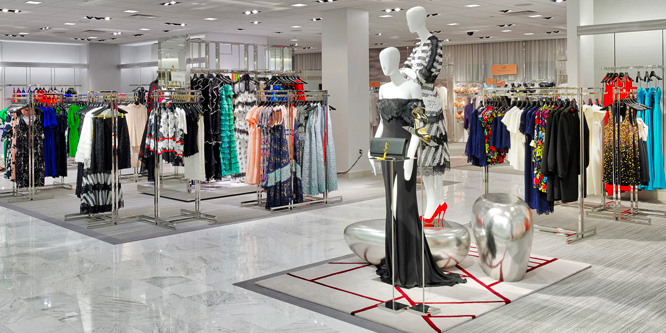
Photo: Neiman Marcus
January 18, 2023
Does Neiman Marcus have too many eggs in too few baskets?
In a keynote presentation at the 2023 NRF Big Show, Geoffroy van Raemdonck, Neiman Marcus Group’s CEO, was asked about the benefits and risks of the retailer’s high concentration levels. Two percent of Neiman’s customer base generates 40 percent of dollar sales, and its 20 largest brands represent half of its revenue.
Addressing the customer-concentration risks, he said the two percent still represents “thousands of customers.”
The benefit to focusing on those high-heeled customers is being able to deliver a more personalized experience. “The value is really that as you get to know someone, you’re able to really provide them what’s right for them, and know their family, know what moments are important to them, and surprise them,” Mr. Raemdonck said.
“We are truly in a relationship business. And that means that we spend time focusing on a few clients who have the potential to engage a lot with us, and we build that relationship so that we drive customer lifetime value,” he added.
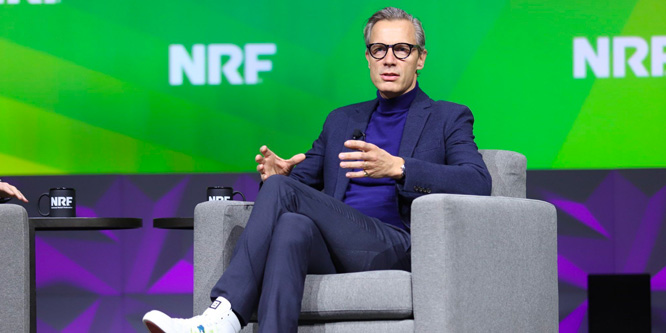
For Neiman Marcus, the benefit is that those two percent shop 25 times at Neiman’s annually and spend $27,000 on average, with 90 percent retained. Since they’re loyal, they’re less promotionally-driven. Said van Raemdonck, “It means that our business is quite predictable because year on year, we start with a solid base of customers.”
Regarding the concentration of vendors, he said Neiman has a core group for brands “that have multiple years of excellence in delivering beautiful product experiences to customers and those thrive in a good economy and they thrive almost better in volatile times.”
He said, “These are brands that resonate, that have integrity, that really appeal to the luxury customer. They’re also brands that sell well. So our business again is quite stable.”
Mr. Raemdonck said Neiman’s also remains committed to stocking emerging brands to support discovery and curation, but the top luxury brands have expanded as part of the mix over the last year due to the exposure and insights Neiman’s provides. He said, “We can represent them at the level and the standard of integrity that they have, but also introduce them to a customer they don’t have today.”
Discussion Questions
DISCUSSION QUESTIONS: Is the concentration of its customer base and vendor base a concern for Neiman’s? What does the high concentration say about success drivers of the luxury model?
Poll
BrainTrust
Liza Amlani
Principal and Founder, Retail Strategy Group
Jeff Sward
Founding Partner, Merchandising Metrics
Recent Discussions

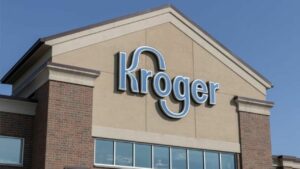
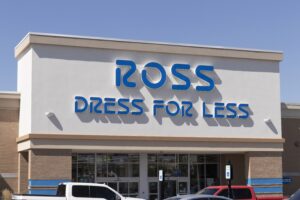

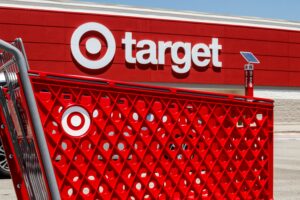
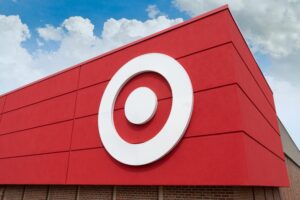

There are risks and benefits. The benefits are that Neiman deeply understands its customers and is able to build extremely strong levels of loyalty. Their core affluent shoppers are also somewhat immune to economic cycles which, at the present time, is highly beneficial. The risk comes from losing even a fraction of those shoppers — from doing the wrong thing or, in the case of older ones, from death. Neiman probably should look to broaden its sales base — especially to make its stores more productive – but it has to do so carefully so as not to alienate the core customer base.
I’ve always known Neiman’s was hyper-focused on the luxury demographic, but hearing these numbers yesterday was still staggering. As the economy has shifted over the years, midrange retail has become less and less relevant, and luxury and low-price have been the two successful spaces. That said, this level of concentration is extremely risky for such a large company that needs to rely somewhat on sheer volume. Neiman’s will have to continue diversifying its partnerships in order to penetrate its target market further since it’s so committed to sticking strictly with luxury consumers.
I agree. This merchandising strategy + marketing strategy is extremely risky. What happens when those loyal 2% of customers age and disappear? Is there investment in another generation’s wants/needs and is this reflected in their merchandising strategy? There must be more to it.
On the other hand, the numbers reflected in revenue and retention are incredible. It would be interesting to better understand how much of their product assortment sells at full price vs. their markdown sales + excess inventory position. This would tell us if they are truly managing their inventory and if Neiman’s merchandising strategy reflects overbuying and over-assorting. I have so many questions.
I worked for a brand a few years ago where 60% of their sales come from 1 leather jacket style. It was shocking. The sales had plateaued by the time I worked with the brand and it was very clear that depending on 1 style to carry an entire brand was a huge risk.
Know what else is shocking? When you attend a NM fashion show and inquire at the store about several items only to be told they don’t come in your size. Come on, I wear a 12. Imagine the possibilities if they expanded their customer horizons?
Mr. Raemdonck didn’t mention whether the core brands are exclusive to Neiman’s and therein lies the problem. Ubiquity is the new exclusivity as most well-known brands leverage multiple business models to stay relevant (wholesale, owned retail, E-commerce, marketplace partnerships, not to mention the flood of resale operators that keep luxury items in circulation). In this world, Neiman’s has to nail customer experience to keep those golden two percent overjoyed and inextricably linked to its platform. It’s a tall, precarious order.
Rather than a concern, I would argue that the narrow concentration of both customers and vendors has allowed Neiman Marcus to create differentiated experiences that are relevant to their best customers. In this world of ridiculous product choice fueling a pricing race to the bottom, Neiman’s targeted, personalized and highly branded approach seems to be working. Twenty-five shopping journeys a year, resulting in an annual spend of $27,000 per customer per year, with over 90% retention? Sign me up.
Great point + agree strongly, Dave. This is a trade-off like any other, but in a world where everyone talks about personalization and loyalty and the imperative for growing LTV, this is actually walking the walk.
Of course, if you’re Neiman you want more consumers to move up the value curve and reach this status of “super shopper,’ but if you deliver excellence and reward those who engage with you that in and of itself can be an acquisition driver for affluent consumers who want the same level of access and service that a Neiman provides.
I actually think the clearest example of this are airlines — as they’ve enriched top-level rewards programs (like Delta Diamond), they’ve created cultural cachet and it becomes something people actively work to achieve.
The risk I see: how is Neiman Marcus, and every luxury retailer, able to recruit and replace those highly loyal, two percenters as they age out of the key target groups?
On the one hand, congratulations on serving a very specific group of customers so well. On the other hand … yikes. 2 percent of customers generate 40 percent of sales. 20 vendors generate 50 percent of sales. That sounds like a highly unusual level of concentration. It’s hard to imagine another retailer hearing this and rushing to emulate the model. I’m all for focus and embracing risk as a differentiator, but this sounds like a high-wire act without a net.
There’s always some level of concern for any business when key customers are limited. Small changes in customer empathy or a shift for a small number of customers looking to shop elsewhere means risk. That said, with such high retention rates and a strong program for bringing new customers into their loyalty fold, Nordstroms reduces this risk tremendously. Nordstrom’s has done a fabulous job catering to their loyal customers with consistency and most customers would forgive minor mistakes and issues. The luxury market enjoys consistency and a flavor of newness — not having a strong store and brand culture is the larger risk that Nordstrom’s won’t have to worry about.
I love this for them. Neiman’s customer base is motivated by exclusivity, white glove service, and premier shopping experiences. As long as Neiman is using the size of their base to their advantage, i.e. training associates to clientele and deepen relationships, storing zero-party customer data to capture selling opportunities, and rolling out the red carpet, this approach gives them an edge where most retailers struggle. I’m less concerned about Neiman losing their base over time than some other brain trusters given that their product assortment covers the entire customer lifecycle (kids, home, apparel, beauty, etc).
Why are we assuming that as the 2% pass, they will not be replaced by younger shoppers entering the affluent demographic? My guess is their 2% demographic is far from passing and, in reality, entering the highest money-earning years.
Neiman Marcus has a strong point of view and always have compared to many of its competitors in retail. Before COVID-19 and the Chapter 11 filing, they had too much going on and over extended themselves now they back to focusing on what they’re truly known for — servicing the luxury customer and focusing on true luxury.
Their core brands are established luxury brands that don’t fall out of favor easily. They’re desirable and often times their sales associate knows how to migrate customers on the cusp to those brands. They’re trained to do that. Every year you have wealthy customers migrating into that core brand even if some died out.
What they’ve done recently is embrace emerging designers. If you go into their stores and on their website they’ve added a whole new bunch of contemporary labels in men’s and women’s. Plus stocking and buying more trendy luxury brands that appeal to young luxury customers. Since Covid this group is shopping more in store and Neiman’s is capturing them. That’s what’s increasing their margins. They’ve not changed their point of view to wholly go after this group and alienate the customer buying Brunello Cucinelli, but they’ve managed both and given the lady wearing Cucinelli more attention through relationship building, personalized experiences, and digital integration. Young customers are buying full price because they want the latest and getting that core customer to shop quickly to get said product. They’ve cut their inventory levels and managed sales. It’s no longer their focus. This is what’s changed for Neiman’s.
Perhaps these (customers) numbers are extreme — we’re probably more used to variants of the 80/20 rule — but aren’t they more-or-less what we’d expect? The nature of a high-end retailer is that it appeals to a very small group of very wealthy people. Or looking at it another way: if the least purchasing three-fourths of the customer base went away, then by definition that 2% would be a larger share, but would NM be better off? The thinking of course is to retain the 2% but grow lower tiers, but what if that’s not possible? Exclusivity is often its own attraction.
Luxury will continue to be a winning strategy for all retailers. The hyper concentration of Neiman’s customer base seems like there is a need for differentiation, but leadership has made many strong moves to straighten the ship after the 2020 bankruptcy filing. The strategy to hone in on their base is paying off; great to see their continued success.